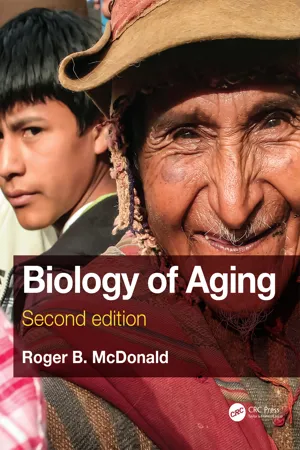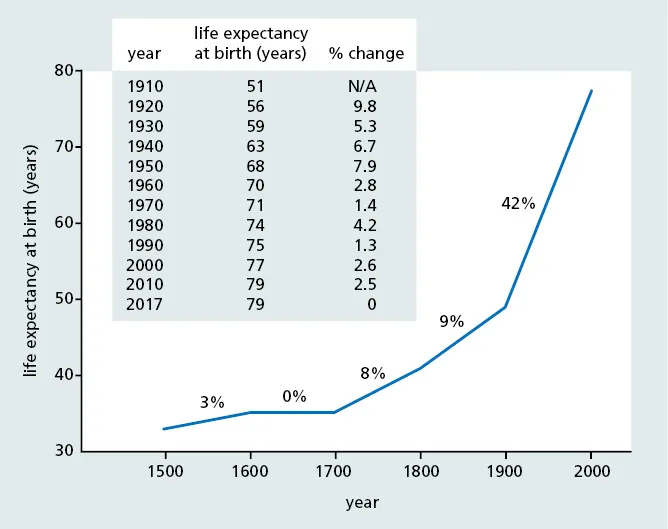
- 432 pages
- English
- ePUB (mobile friendly)
- Available on iOS & Android
Biology of Aging
About this book
Biology of Aging, Second Edition presents the biological principles that have led to a new understanding of the causes of aging and describes how these basic principles help one to understand the human experience of biological aging, longevity, and age-related disease. Intended for undergraduate biology students, it describes how the rate of biological aging is measured; explores the mechanisms underlying cellular aging; discusses the genetic pathways that affect longevity in various organisms; outlines the normal age-related changes and the functional decline that occurs in physiological systems over the lifespan; and considers the implications of modulating the rate of aging and longevity. The book also includes end-of-chapter discussion questions to help students assess their knowledge of the material.
Roger McDonald received his Ph.D. from the University of Southern California and is Professor Emeritus in the Department of Nutrition at the University of California, Davis. Dr. McDonald's research focused on mechanisms of cellular aging and the interaction between nutrition and aging. His research addressed two key topics in the field: the relationship between dietary restriction and lifespan, and the effect of aging on circadian rhythms and hypothalamic regulation. You can contact Dr. McDonald at [email protected].
Related Titles
Ahmad, S. I., ed. Aging: Exploring a Complex Phenomenon (ISBN 978-1-1381-9697-1)
Moody, H. R. & J. Sasser. Gerontology: The Basics (ISBN 978-1-1387-7582-4)
Timiras, P. S. Physiological Basis of Aging and Geriatrics (ISBN 978-0-8493-7305-3)
Frequently asked questions
- Essential is ideal for learners and professionals who enjoy exploring a wide range of subjects. Access the Essential Library with 800,000+ trusted titles and best-sellers across business, personal growth, and the humanities. Includes unlimited reading time and Standard Read Aloud voice.
- Complete: Perfect for advanced learners and researchers needing full, unrestricted access. Unlock 1.4M+ books across hundreds of subjects, including academic and specialized titles. The Complete Plan also includes advanced features like Premium Read Aloud and Research Assistant.
Please note we cannot support devices running on iOS 13 and Android 7 or earlier. Learn more about using the app.
Information

| Table 1.1 Leading Causes of Death in United States for Years 1900 and 2015 | |||
| 1900 | % of deaths | 2015 | % of deaths |
| Influenza and pneumonia | 12 | Heart disease | 23 |
| Tuberculosis | 11 | Cancer | 22 |
| Diarrheal disease | 8 | Chronic obstructive pulmonary disease | 6 |
| Heart disease | 8 | Unintentional injuries (medical errors) | 5 |
| Stroke | 6 | Stroke | 5 |
| Kidney disease | 5 | Alzheimer’s disease | 4 |
| Accidents | 4 | Diabetes mellitus | 3 |
| Cancer | 4 | Influenza and pneumonia | 2 |
| Senilitya | 3 | Kidney disease | 1 |
| Diphtheria | 2 | Suicide | 1 |
| aAll dementias were referred to as senility. Alzheimer’s disease had not yet been characterized. | |||
Table of contents
- Cover
- Half Title
- Title Page
- Copyright Page
- Dedication
- Contents
- Detailed Contents
- Preface
- Preface to the First Edition
- Acknowledgements
- CHAPTER 1: BASIC CONCEPTS IN THE BIOLOGY OF AGING
- CHAPTER 2: MEASURING BIOLOGICAL AGING
- CHAPTER 3: EVOLUTIONARY THEORIES OF LONGEVITY AND AGING
- CHAPTER 4: CELLULAR AGING
- CHAPTER 5: GENETICS OF LONGEVITY
- CHAPTER 6: PLANT SENESCENCE
- CHAPTER 7: HUMAN LONGEVITY AND LIFE SPAN
- CHAPTER 8: COMMON FUNCTIONAL LOSS ASSOCIATED WITH AGING
- CHAPTER 9: COMMON TIME-DEPENDENT DISEASE IN HUMANS
- CHAPTER 10: MODULATING HUMAN AGING AND LONGEVITY
- CHAPTER 11: IMPLICATIONS OF AN EXTENDED HEALTHSPAN
- APPENDIX: US LIFE TABLE CALCULATIONS
- GLOSSARY
- INDEX